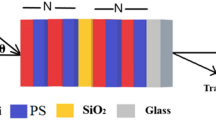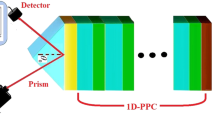Abstract
Based on the Green function method and by taking account of the thermal expansion effect and thermo optical effects, we theoretically investigates the transmittance spectra of a one dimensional photonic crystal (PC) with two defects layers designed as (AB)6CBC(BA)6 made of Silicon dioxide (SiO2), Titanium dioxide (TiO2), and Bi4Ge3O12 (BGO). Numerical results show that the defect mode shifts toward the low frequencies region as the temperature of the structure increases and the central wavelength of defect modes changes linearly with temperature. The proposed structure may be used as a low temperature sensor.
Access provided by Autonomous University of Puebla. Download conference paper PDF
Similar content being viewed by others
Keywords
1 Introduction
A one-dimensional photonic crystal (1DPC) is an artificial microstructure consisting of media with different indices of refraction that are periodically arranged in the same dimension.
The most important feature of a photonic crystal is the photonic band gap (PBG) which consists of a range of frequencies where the photon can be controlled and manipulated effectively, this feature has led to the development of a wide range of optical devices for different applications.
When the periodicity of a PC is interrupted, by changing the thickness of a layer, or by adding a different medium in the perfect photonic crystal, some defective modes could be generated within the PBGs. The defect mode is a highly localized defect mode witch, in general, can be seen in the transmission spectrum with a narrow resonant peak. With the presence of a resonance peak in the transmission spectrum, the structure can be used to function as a sensor [1,2,3].
In this article we propose a very sensitive photonic structure that can be used as a thermal sensor. The photonic structure is composed of an alternation of two layers, with low refractive index layer (Silicon dioxide SiO2), and high refractive index layer (Titanium dioxide TiO2), and with two defects layers of different thicknesses and different material.
2 Model and Method of Calculation
The proposed photonic structure is schematically shown in Fig. 1. It is made of stacked layers containing two defects layers [4, 5] with a different thicknesses, and different material. The light coming from the source goes through the photonic crystal and is transmitted in the outgoing medium. The one-dimensional photonic structure considered in this work can be expressed as (AB)6CBC(BA)6, where A and B stand for the different layers with high and low refractive index nA and nB, respectively, C is the defect layer. The defect layer consists of the Bi4Ge3O12 (BGO) of the thickness dC. In our calculation, the material parameters of the dielectric material are taken from Ref. [6]. We assume the layers A of the thickness dA to be Titanium dioxide (TiO2). The layers B of the thickness dB are Silicon dioxide (SiO2). The period of the structure is D = dA + dB. The medium surrounding the PC is a vacuum. The materials constituting the layers A, B, and C of the structure are assumed homogeneous, and nonmagnetic.
Serval researches have studied the propagation of optical waves through these composite systems using theoretical methods such as the transfer matrix, the plane-wave method, and so on. However, the plane-wave method is well suited to the study of the band diagram of an infinite superlattice, but it is not adapted to the study of periodicity defects.
In this work, to investigate the temperature dependent defect mode, we shall use the transmission spectrum which can be calculated by the Green function method. This method makes it possible to obtain the transmission coefficients in any type of composite system. The Green function is calculated by using the theory of interface response in composite materials. In this theory, the Green function g of a composite system can be written as
where D and M are, respectively, the whole space and the space of the interfaces in the composite material. G is a block-diagonal matrix in which each block Gi corresponds to the bulk Green function of the subsystem i. In our case, the composite material is composed of a SL built out of alternating slabs of materials i (i = A, B) with thickness di. In Eq. (1) the calculation of g(DD) requires, besides Gi, knowledge of g(M M). In practice, the latter is obtained by inverting the matrix g−1(M M), which can be simply built from a juxtaposition of the matrices g −1si (M M), where g −1si (M M) is the interface Green’s function of the slabs i (i = A, B) and of the substrate alone.
Within this theory, the reflected and transmitted waves u(D), resulting from a uniform plane wave U(D) incident upon a plane boundary between two different media, are given by
3 Discussion and Numerical Results
It can be seen from Fig. 2 that there is a PBG in the range of reduced frequency 0.81–0.89. Our aim is to engineer this PBG to producing a defect mode, which can be tuned by the temperature.
In order to see the effect of the defect layers, we now replace the central layers of TiO2 by Bi4Ge3O12. The defective PC has a structure of (AB)6CBC(BA)6 embedded in the air, as shown in Fig. 1. The calculated transmittance of this structure at a fixed temperature of 20 °C is shown in Fig. 3. It can be seen that a transmittance peak is produced within the PBG. This transmittance peak is referred as a defect mode. With the appearance of this peak, the structure is used to function as a sensor. In what follows, we shall investigate how this defect mode can be shifted by the temperature change.
The temperature dependence of defect mode arises from two factors. One factor is due to the thermal expansion which will cause the thicknesses of the constituent layers to be a function of the temperature. The other one is the so-called thermal–optical effect, that is, the index of refraction of the layer can be varied as the temperature changes. Both factors will be simultaneously considered in the following study. For the thermal expansion, the thickness d of each layer changes in the following manner,
In Eq. (3), α is the thermal expansion coefficient, and ΔT is the temperature variation. The thermal expansion coefficients of TiO2 and SiO2 are 8 × 10−6/°C and 5.5 × 10−7/°C [7], respectively. As for thermal-optical effect, the temperature dependence of index of refraction n of each layer is written by,
In Eq. (4), β is the thermo-optic coefficient. The thermal-optic coefficients of TiO2 and SiO2 are 2.31 × 10−5/°C [8], and 1 × 10−5/°C [9], respectively.
The index of refraction of BGO is nBGO = 2.13; the thermal expansion coefficient is αBGO = 6.3 × 10−6/°C; and its thermo-optic coefficient is βBGO = 3.9 × 10−5/°C. We chose the BGO as a defect layer because our photonic structure with this material allowed to reach a high sensitivity.
With the inclusion of Eqs. (3) and (4), the calculated transmittance spectra at four different temperatures 45, 125, 225, and 325 °C are plotted in Fig. 4 and the variation of the corresponding transmittance peaks with temperature is shown in Fig. 5. It is seen that as the temperature of the structure increases, the defect mode shifts toward the low frequencies region. The dependence of defect modes on temperature is due to two factors. First one is the thermal expansion effect and the second one due to the dependence of refractive index on temperature. The shifting behavior can be explained as well. When the thickness d and index of refraction n of each layer increase, the wavelength λ must increase accordingly to keep the phase ϕ unchanged. It is also found (Fig. 5.) that the central wavelength of defect modes changes linearly with temperature.
The frequency of transmittance peak at low temperature variations are shown in Fig. 6. for 327 °C the peak is at the reduced frequency 0.85646, and for 330 °C the peak is at the reduced frequency 0.85632. A temperature variation of 3 °C induces a shift of 0.00014. Therefore the limit of detection of the temperature is 3 °C.
4 Conclusion
The phenomenon of the transmission optical waveguide through a photonic crystal structure having a defect mode can be advantageously used for temperature detection. The effect of the temperature on the defect mode in a one-dimensional dielectric PC with two defects layers has been investigated by simultaneously considering thermal expansion effect and thermal–optical effect. It is found that the defect mode shifts toward the low frequencies region as the temperature of the structure increases.
We have shown also that the proposed structure is very sensitive to temperature variation. A variation of 3 °C is clearly visible.
References
Bouzidi A, Bria D, Akjouj A, Yann P, Braham DR (2015) A tiny gas-sensor system based on 1D photonic crystal. J Phys D Appl Phys 48:495102
Bouzidi A, Bria D, Akjouj, A, Berkhli H (2016) Optical liquid sensor based on periodic multilayers structure. IEEE, pp 245–249
Bouzidi A, Bria B, Falyouni F, Akjouj A, Lévêque G, Azizi M, Berkhli H (2017) A biosensor based on one-dimensional photonic crystal for monitoring blood glycemia. J Mater Environ Sci 8:3892–3896
Ben-Ali1 Y, Tahri1 Z, Bouzidi A, Jeffali F, Bria D, Azizi M, Khettabi A, Nougaoui A. (2017) Propagation of electromagnetic waves in a one-dimensional photonic crystal containing two defects. J Mater Environ Sci 8:870–876
Ghadban A, Ghoumid K, Bouzidi A, Bria D (2016) Coupled selective electromagnetic waves in 1D photonic crystal with two planar cavities. In: International conference on multimedia computing and systems
Chang YH, Jhu YY, Wu CJ (2012) Temperature dependence of defect mode in a defective photonic crystal. Opt. Commun. 285:1501–1504
Singh SP, Pal K, Tarafder A, Das M, Annapurna K, Karmakar B (2010) Effects of SiO2 and TiO2 fillers on thermal and dielectric properties of eco-friendly bismuth glass microcomposites of plasma display panels. Bull Mater Sci 33:33–41
Wiechmann S, Müller J (2009) Thermo-optic properties of TiO2, Ta2O5 and Al2O3 thin films for integrated optics on silicon. Thin Solid Films 517:6847
Baraket Z, Zaghdoudi J, Kanzari M (2017) Investigation of the 1D symmetrical linear graded superconductor dielectric photonic crystals and its potential applications as an optimized low temperature sensors. Opt Mater 64:147–151
Author information
Authors and Affiliations
Corresponding author
Editor information
Editors and Affiliations
Rights and permissions
Copyright information
© 2019 Springer Nature Singapore Pte Ltd.
About this paper
Cite this paper
Bouzidi, A., Bria, D. (2019). Low Temperature Sensor Based on One-Dimensional Photonic Crystals. In: Hajji, B., Tina, G.M., Ghoumid, K., Rabhi, A., Mellit, A. (eds) Proceedings of the 1st International Conference on Electronic Engineering and Renewable Energy. ICEERE 2018. Lecture Notes in Electrical Engineering, vol 519. Springer, Singapore. https://doi.org/10.1007/978-981-13-1405-6_20
Download citation
DOI: https://doi.org/10.1007/978-981-13-1405-6_20
Published:
Publisher Name: Springer, Singapore
Print ISBN: 978-981-13-1404-9
Online ISBN: 978-981-13-1405-6
eBook Packages: EngineeringEngineering (R0)










